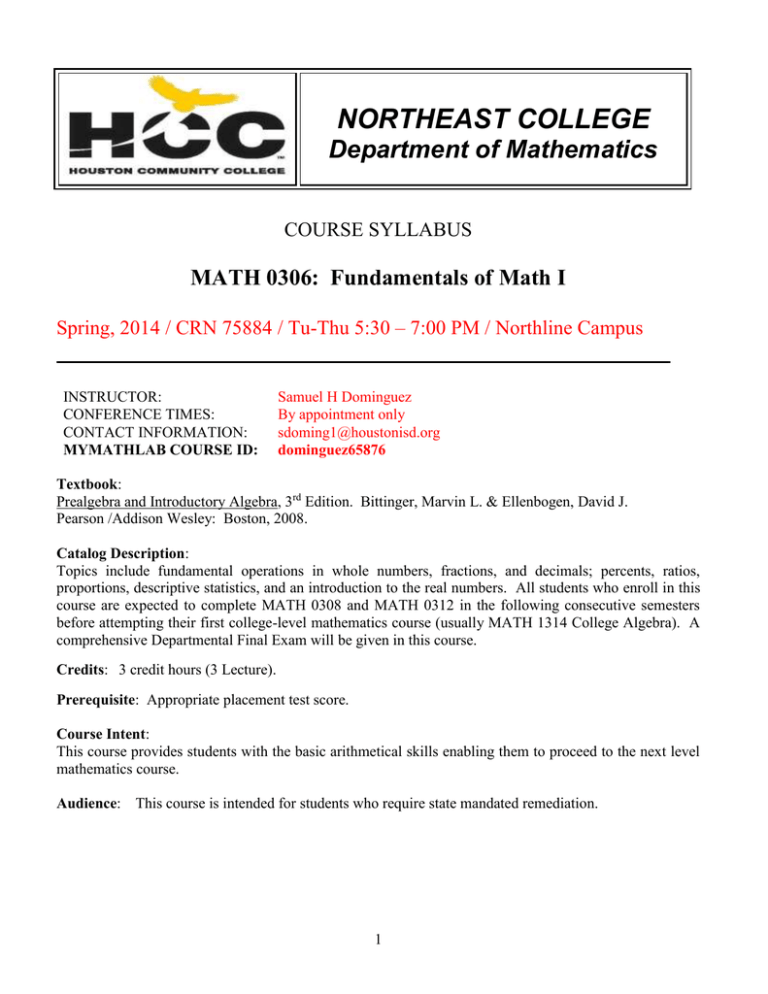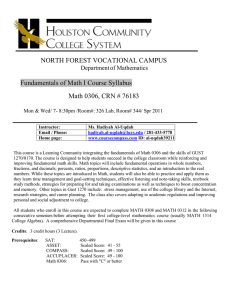
NORTHEAST COLLEGE
Department of Mathematics
COURSE SYLLABUS
MATH 0306: Fundamentals of Math I
Spring, 2014 / CRN 75884 / Tu-Thu 5:30 – 7:00 PM / Northline Campus
INSTRUCTOR:
CONFERENCE TIMES:
CONTACT INFORMATION:
MYMATHLAB COURSE ID:
Samuel H Dominguez
By appointment only
sdoming1@houstonisd.org
dominguez65876
Textbook:
Prealgebra and Introductory Algebra, 3rd Edition. Bittinger, Marvin L. & Ellenbogen, David J.
Pearson /Addison Wesley: Boston, 2008.
Catalog Description:
Topics include fundamental operations in whole numbers, fractions, and decimals; percents, ratios,
proportions, descriptive statistics, and an introduction to the real numbers. All students who enroll in this
course are expected to complete MATH 0308 and MATH 0312 in the following consecutive semesters
before attempting their first college-level mathematics course (usually MATH 1314 College Algebra). A
comprehensive Departmental Final Exam will be given in this course.
Credits: 3 credit hours (3 Lecture).
Prerequisite: Appropriate placement test score.
Course Intent:
This course provides students with the basic arithmetical skills enabling them to proceed to the next level
mathematics course.
Audience: This course is intended for students who require state mandated remediation.
1
Testing policy:
We will have four regular tests during the semester. Each regular test will be worth 100 points. I will use
the three highest scores to average with one final exam worth 200 points for your semester grade.
Make-up policy:
No make-up tests will be given this semester.
Grading policy:
Your final course grade is based on the following standard HCC scale.
FINAL AVERAGE
FINAL COURSE GRADE
90 ≤ Average ≤ 100%
A
80 ≤ Average < 90%
B
70 ≤ Average < 80%
C
60 ≤ Average < 70%
D
Average < 60%
F
A grade of “IP” (In Progress) will NOT be given. However, if your final grade is a “D”, then you
may be eligible to take the bridge course MATH 0106 instead of repeating the class. To determine
eligibility, please contact the math department.
Semester Grade = (test # 1 + test # 2 + test # 3 + Final Exam)/5
Final Examination:
The final examination is departmental and consists of 40-50 multiple-choice problems. The problems
cover all the material required in the course.
Homework policy:
All homework must be completed online using MYMATHLAB. The MyMathLab Course ID to be used
for registration purposes is dominguez65876, and the school zip code is 77022. To register for
MyMathLab and to access the homework, go to www.coursecompass.com.
Homework will be assigned every Thursday and it is due the following Tuesday.
Calculators:
Calculators will not be allowed in this course.
Attendance policy:
Attendance is checked during every class. The instructor may drop you for excessive absences.
Tardiness policy:
If you are chronically late, you will be referred to a counselor for possible intervention.
Withdrawal policy:
2
If you decide to drop the class, then IT IS YOUR RESPONSIBILITY TO DROP before the final
drop date.
If your name is on the roll at the end of the term, you WILL receive a grade. Neither you nor your
instructor will be able to perform the drop after the final drop date. Please refer to the following notice
before dropping the class.
NOTICE: Students who take a course three or more times will face significant tuition or
fee increases at HCC and other Texas public colleges and universities. In addition, state law
allows students a maximum of 6 course withdrawals during their entire college career. Students
with more than 6 drops will be required to pay additional fees. Prior to course withdrawal, you
must confer with your professor or counselor about your study habits, homework, test-taking
skills, attendance, course participation, and tutoring or other assistance that is available.
Student conduct:
Students should not engage in disruptive activities while in the classroom. Any conduct that is deemed
detrimental to the academic atmosphere, such as cell phone use or consistently talking during instructional
delivery, will not be tolerated. Any student found guilty of such conduct will be asked to leave the
classroom until further notice.
Academic dishonesty:
All students are required to exercise academic honesty in completion of all tests and assignments.
Cheating involves deception for the purpose of violating testing rules. Students who improperly assist
other students are just as guilty as students who receive assistance. A student guilty of a first offense will
receive a grade of “F” on the quiz or test involved. For a second offense, the student will receive a grade
of “F” for the course. The use of recording devices, including camera phones and tape recorders, is
prohibited in all locations where instruction, tutoring, or testing occurs. Students with disabilities who
need to use a recording device as a reasonable accommodation should contact the Disability Services
Office for information.
Resources and supplemental instruction:
Any student enrolled in Math 0306 at HCC has access to the math tutoring labs which are staffed with
student assistants who can aid students with math problems and offer help with MYMATHLAB. In
addition, free online tutoring is provided. For more information and for tutoring hours and locations, go
to the math department web page at http://swc2.hccs.edu/math/, and select the tutoring link. One other
resource is the student solutions manual that may be obtained from the bookstore.
Students with Disabilities:
Any student with a documented disability (e.g. physical, learning, psychiatric, vision, hearing, etc.) who
needs to arrange reasonable accommodations must contact the Disability Support Services Office at this
college at the beginning of the semester. To make an appointment, please call 713-718-7910. Professors
are authorized to provide only the accommodations requested by the Disability Support Office.
Course Schedule:
Chapters and Sections
Chapter 1 WHOLE NUMBERS
1.1
Standard Notation
3
1.2
1.3
1.4
1.5
1.6
1.7
1.8
1.9
Addition
Subtraction
Rounding and Estimating; Order
Multiplication and Area
Division
Solving Equations
Applications and Problem Solving
Exponential Notation and Order of Operations
Chapter 2 INTRODUCTION TO INTEGERS & ALGEBRAIC EXPRESSIONS
2.1
2.2
2.3
2.4
2.5
2.6
2.7
2.8
Integers and the Number Line
Addition of Integers
Subtraction of Integers
Multiplication of Integers
Division of Integers and Order of Operations
Introduction to Algebra and Expressions
Like Terms and Perimeter
Solving Equations
Chapter 3 FRACTION NOTATION: MULTIPLICATION & DIVISION
Multiples and Divisibility
3.1
3.2
3.3
3.4
3.5
3.6
3.7
Factorizations
Fractions and Fraction Notation
Multiplication of Fractions
Simplifying
Multiplying, Simplifying, and More with Area
Reciprocals and Division
Solving Equations: The Multiplication Principle
Chapter 4 FRACTION NOTATION: ADDITION, SUBTRACTION, AND
MIXED NUMBERS
4.1
4.2
4.3
4.4
4.5
4.6
4.7
Least Common Multiples
Addition, Order, and Applications
Subtraction, Equations, and Applications
Solving Equations: Using the Principles Together
Mixed Numerals
Addition and Subtraction of Mixed Numerals; Applications
Multiplication and Division of Mixed Numerals; Applications
Chapter 5 DECIMAL NOTATION
4
5.1
5.2
5.3
5.4
5.5
5.6
5.7
5.8
Decimal Notation
Addition and Subtraction of Decimals
Multiplication of Decimals
Division of Decimals
More with Fraction Notation and Decimal Notation
Estimating
Solving Equations
Applications and Problem Solving
Chapter 6 PERCENT NOTATION
6.1 Ratio and Proportion
6.2 Percent Notation
6.3 Percent and Fraction Notation
6.4 Solving Percent Problems Using Percent Equations
6.5 Solving Percent Problems Using Proportions
6.6 Applications of Percent
6.7 Sales Tax, Commission, Discount, and Interest
Chapter 7 DATA, GRAPHS, AND STATISTICS
7.1 Averages, Medians, and Modes
7.2 Tables and Pictographs
7.3 Bar Graphs and Line Graphs
Important Dates:
Drop Deadline: TBA
Final Review Session: Last day of class
Course Objectives:
Upon completion of this course, a student should be able to:
1. add, subtract, multiply, and divide whole numbers, understand the order of
operations, and solve problems involving exponential notation.
2. solve problems by estimating and rounding.
3. add, subtract, multiply, and divide integers.
4. find the least common multiple of two or more integers.
5. add, subtract, multiply, and divide fractions.
6. add, subtract, multiply, and divide with decimals.
5
7. simplify algebraic expressions.
8. solve problems involving ratio and proportion.
9. solve problems involving percent.
10. read and interpret data from tables, pictographs, bar graphs, and line graphs.
6




